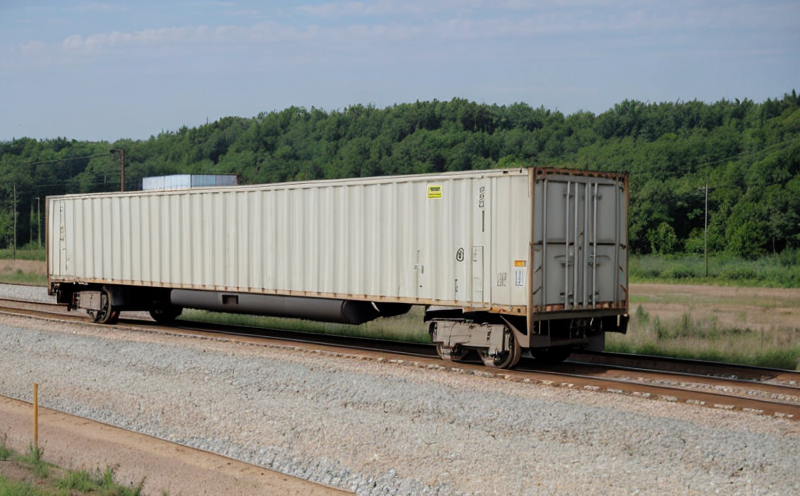EN 15595 Parking Brake Testing of Freight Wagons
The European standard EN 15595 specifies the requirements for parking brakes on freight wagons in railway systems. This regulation ensures that freight wagons are equipped with reliable braking systems capable of holding stationary vehicles safely under a variety of conditions, including gradients and ambient temperatures.
The testing procedure outlined in EN 15595 is critical to maintaining operational safety and compliance within the railway sector. It applies not only to new manufacturing but also to existing wagons during maintenance intervals. The test ensures that braking systems function correctly under both static and dynamic conditions, which are essential for preventing accidents on rail networks.
For quality managers and compliance officers, understanding this standard is crucial as it directly affects the safety of railway operations. R&D engineers must ensure their designs meet these stringent requirements to prevent failures in service. Procurement teams also need to be aware of these standards when selecting suppliers to guarantee reliable components for braking systems.
The EN 15595 test involves several critical steps: first, the wagon is positioned on a gradient similar to those found in real-world conditions. Then, the parking brake system is activated and held until the specified holding time (typically several hours). During this period, various parameters such as temperature, load, and environmental factors are monitored closely.
The test not only checks the effectiveness of the braking mechanism but also ensures that it can withstand extreme conditions. This includes high temperatures which might occur during summer operations or low temperatures experienced in winter months. The standard also considers the impact of varying loads on the performance of parking brakes, ensuring they remain effective regardless of cargo weight.
Failure to meet these stringent requirements could lead to significant safety issues and potential non-compliance penalties imposed by regulatory bodies. Therefore, adhering strictly to EN 15595 ensures that all components are rigorously tested before deployment in operational environments.
Scope and Methodology
| Test Parameters | Description |
|---|---|
| Gradient Testing | The test is conducted on gradients ranging from 0% to 15%, simulating real-world conditions. |
| Holding Time | The parking brake must hold for a minimum of 24 hours without releasing. |
| Load Conditions | The test includes static and dynamic loading scenarios representing normal operational loads. |
| Temperature Extremes | Testing is conducted at both high (50°C) and low (-30°C) temperatures to ensure robustness under all conditions. |
The methodology for EN 15595 involves detailed preparation of the test wagon, including attaching sensors to monitor key parameters such as temperature changes inside the brake housing. Once these preparations are complete, the wagon is placed on a gradient and connected to power sources needed for activation.
During the holding period, continuous monitoring ensures that no unintended release occurs. If any fault or anomaly is detected during this phase, immediate corrective action must be taken by the manufacturer or service provider. After successful completion of the test, detailed reports are generated summarizing all observations and results from each parameter tested.
Quality and Reliability Assurance
- Consistent Testing Protocols: Adherence to standardized procedures ensures consistent results across multiple tests.
- Rigorous Calibration: Instruments used in the testing process are regularly calibrated against international standards to maintain accuracy.
- Data Analysis: Comprehensive analysis of collected data provides insights into potential areas requiring improvement.
- Expert Review: Results undergo scrutiny by experienced engineers who provide feedback on performance and any necessary adjustments.
The quality assurance process ensures that every aspect of the testing procedure is meticulously followed. This includes regular calibration of equipment, consistent application of test protocols, thorough data analysis, and expert review of findings. These measures help maintain high standards in testing and contribute significantly to reliability assurance.
By focusing on these critical aspects, laboratories equipped with advanced facilities can provide accurate and reliable results that comply with EN 15595 requirements. This enhances trust among clients who rely on such services for ensuring the safety and efficiency of their railway operations.
Environmental and Sustainability Contributions
The implementation of EN 15595 has several positive environmental impacts by enhancing overall rail safety, which indirectly supports sustainable practices. Reliable braking systems contribute to safer train operations, reducing the risk of accidents that may result in derailments or collisions.
Such incidents can lead to substantial disruptions, increased fuel consumption due to detours and delays, and higher emissions from additional locomotive use during recovery efforts. By ensuring compliance with EN 15595, railway systems operate more efficiently and safely, thereby promoting better resource utilization and reduced environmental impact.
The standard also encourages the development of greener technologies for braking mechanisms, which can contribute to lower carbon footprints over time. For instance, innovative materials or designs that improve energy efficiency during braking processes help reduce overall emissions from railway operations.





